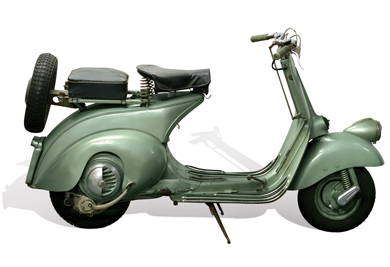very good
4.7 / 5
Shipping today with order in 12 h 46 min
Postage free from 99€ (DE)
High customer satisfaction
Shipping today with order in 12 h 46 min

The V1T was the first 125 cc model to be produced by the Piaggio factories. Compared to the V98, it was technically revised in key points. In addition to the cylinder bore being enlarged from 50 mm to 56.5 mm, the fixing bolts of the gearshift segment were doubled (in Tecnica: "the fixing bolt of the gearshift cross cover") in order to eliminate the faults that had occurred on the V98. The carburetor is still a Dell'Orto TA 17, but now with a flap on the air filter as a choke, which is operated via a cable with a lever under the swinging saddle. The steering tube is now routed down to the front swingarm on the right-hand side of the scooter instead of the left-hand side in the direction of travel, which has a completely new suspension system. Instead of the previous leaf springs, a coil spring is now installed parallel to the steering tube.
The shift linkage is now routed inside the frame tunnel from the brake pedal to above the mounting bolts of the engine swingarm. The rear wheel now also has a suspension consisting of a coil spring and a hydraulic damper.
The hood is movably attached at the top with two hinges and is fixed to the frame at the bottom with a spring catch. The circular opening in the hood on the V98 is now open at the bottom on the V1T so that the engine can oscillate. The frame opening through which the intake manifold is routed from the carburetor to the cylinder is enlarged to give it more freedom of movement with the now sprung engine. The saddle is now also sprung at the front and a luggage hook is installed underneath the saddle tip.
Finally, there is a simple side stand so that you no longer have to lean the Vespa on the footboard when parking it. The light switch and rear light are still the same as on the V98 on the first models, but are then changed: the switch is fan-shaped with a black plastic base and a chrome-plated cover; the rear light no longer has a frame.
The horn is given a new shape and an externally mounted central adjustment screw. The front headlight with Siem disk and chrome ring has a diameter of 95 mm and a decorative fin made of chrome-plated Zamak (die-cast zinc). The carburetor flap has a spring and small rubber buffers are attached to the frame to dampen the vibrations of the flap. The tank is fitted with a fuel tap with reserve position, which is opened or closed with a hook-shaped (still ring-shaped on the V98) operating lever. The fuel filler cap on the first models was spring-loaded with a quick-release fastener, which was not used again on the GS until 1955. The Piaggio logo is now on the redesigned rubber grips, while the aluminum plugs on the handlebar ends remain. The "Genova" lettering on the leg shield emblem is slightly larger than on the V98.
In model year 1949, the cylinder and cylinder head are modified for better cooling. The cooling fins of the cylinder no longer ran perpendicular to the cylinder base, but parallel. This shape is retained in all later models to this day. The diameter of the piston pin is increased from 12 mm to 15 mm. The flange of the intake manifold is fastened with three stud bolts instead of the previous two. (Source: GSF)
Frame numbers by year of manufacture:
1949-1950: V1T-V15T 1-104096
Number of V1 units: not known
Number of V1-V15 units: 104,096


